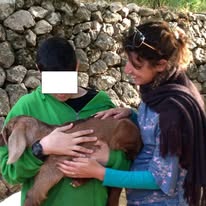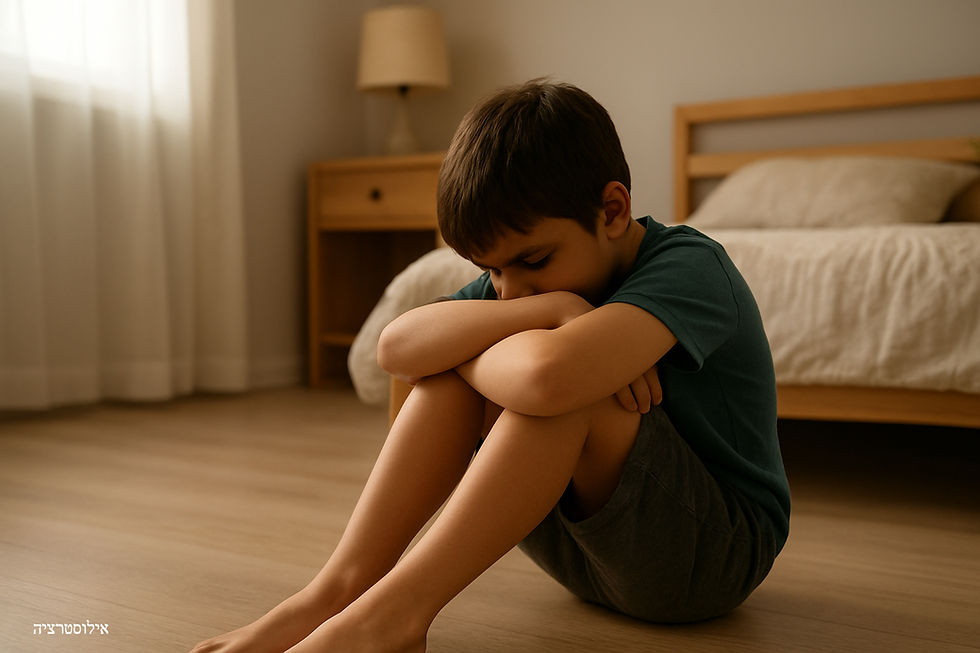The Wounded Healer: Circles of Mutual Healing in Animal-Assisted and Nature-Based Psychotherapy
- Ori Ben Onn
- Sep 14
- 4 min read
Inbal Grinberg
Amsterdam, IAHAIO Conference, August 2025
Opening
“There is a crack in everything. That’s how the light gets in.” - Leonard Cohen

In early October 2023, life in Israel was ruptured in an instant. A violent attack shattered the sense of safety, tore apart families, and left entire communities uprooted.
Within days, thousands of people were living in hotels and temporary shelters, surrounded by fear, grief, and uncertainty.
As psychotherapists, we entered those hotels not with answers but with a need to offer something human: relief, presence, even a sliver of normalcy. Jason, my brother’s Labrador, was by my side. He did what animals do best: he connected. While “helping” clean pizza crusts off the floor, he also nudged his way into the withdrawn silence of a teenage girl who had not spoken in days. When she looked up, I asked if she knows where I can find some water for him? the girl stood up to help. she became, for a moment, the caregiver, and spent the next hours with us, That moment captured the essence of this essay: the fragile yet transformative spaces of mutual healing, where roles of healer and healed are never fixed, and where humans and animals together create possibilities of repair.
The Wounded Healer

The figure of the wounded healer originates in the myth of Chiron, the centaur abandoned at birth because of his hybrid form.His primal wound became the source of his sensitivity and wisdom. Though unable to heal himself, he guided others, including Asclepius, the god of medicine.
Carl Jung (1961) described the wounded healer as an archetype within us all. The therapist’s role, he suggested, is not to erase suffering but to hold space for both light and darkness.
In animal-assisted psychotherapy, this archetype gains a third presence: the animal. Animals embody both vulnerability and resilience, inviting us into honest, grounded connection.
Vignette One: The Girl and the Displaced Chickens
During the first weeks of the war, our therapeutic farm in Jerusalem received hens evacuated from conflict zones. Seventeen disoriented birds arrived after their coop had been destroyed by a missile.
At the same time, I began working with a six-year-old patient whose family had been displaced from northern Israel.
On her first visit she stopped by the chicken coop. “Why are some brown and some white?” she asked.
“The colorful ones have lived here for a while,” I explained. “The white ones are evacuees, like you.” Her eyes lit up: “Like me!”. Week after week, she returned to check on the hens. She marveled at their tentative steps into new spaces, empathized with their fear, and celebrated their growing confidence. Before her family returned north, she asked me: “If I come back to Jerusalem, can I visit you and the animals again? And what about the hens? Will they still be here? ”
When I assured her that the farm was now their home, she paused and said softly: “They’re lucky. If they have a quiet place, someone will help them get used to it.” She had named the essence of healing: safety first, then adaptation.
Vignette Two: The Therapist, the Patient, and the Dead Gerbil
At another of our centers, an 11-year-old boy came for therapy after losing his brother in combat. His therapist, herself deeply affected by the war, prepared for their first meeting with humility and care.
As they walked through the farm, they reached the gerbil enclosure, one gerbil lay motionless on its back.
“Is he dead?” the boy asked.
Startled, the therapist replied: “Maybe he’s sick. We’ll check and take him to the vet.”
Later, in supervision, she admitted her panic. Facing death so early in treatment, and carrying her own grief, she had chosen denial.
In a later session, she revisited the moment:
“I checked, and he had passed away. Actually, I thought he was dead when we saw him, but I was so surprised I didn’t know how to say it.”
The boy said nothing. He brushed something off his sweater, eyes averted. Yet the therapist’s honesty, her willingness to sit with death, quietly reopened space for truth.
Healing, here, came not from shielding the patient from pain, but from daring to acknowledge it.
Vignette Three: Animals as Life Holders
This essay is also born from my own loss. After the funeral of my cousin's son Or, whose name means “light” in Hebrew, the silence at home was unbearable.
Then, almost by accident, a tiny abandoned kitten arrived, rescued from a car engine. Two weeks later, a lively dog joined the family. Their presence did not erase grief, but they filled the house with chatter, warmth, and movement. In Hebrew, the word for animals is ba’alei chayim – “holders of life.” They carried life back into the wounded spaces of our days.
Reflection
Psychotherapy exposes us to suffering. If therapists cling to the illusion of being healthy while patients are sick, encounters risk becoming sterile. True healing begins when we acknowledge our own fragility. Animals remind us that survival and vitality can coexist with trauma.
Chickens resume pecking even after missiles. Dogs tremble at explosions, yet seek comfort in our presence. Children find in animals both mirrors and companions for their own resilience.
The boundary between healer and healed is porous, shifting, alive. Each encounter is a circle of mutual influence.
Conclusion

As therapists, as patients, as human beings, we cannot and should not hide our wounds. Instead, we may learn to let them become light – fragile, flickering, but guiding us back toward life.
At the 2025 IAHAIO Conference in Amsterdam, far from my home in Jerusalem hills, I carried with me both grief and gratitude.
In a time of rupture, animals and humans together remind us that healing is not perfection, but presence. It is not escape from pain, but the willingness to dwell within it long enough to glimpse the life that insists on returning.
May we continue to walk, wounded yet healing, fragile yet alive, together.
Dedication

This article is dedicated to the memory of Staff Sergeant Or Blomovitz, who fell in service on June 15, 2024, at the age of 20.
Or was a gentle, curious, and compassionate young man who loved animals deeply. May his memory be a blessing and continue to light our way.
















